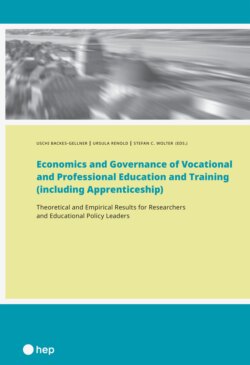Читать книгу Economics and Governance of Vocational and Professional Education and Training (including Apprenticeship) (E-Book) - Uschi Backes-Gellner - Страница 19
На сайте Литреса книга снята с продажи.
2.4.2 Classification Scheme for VET Programs
ОглавлениеTable 2 provides a nonexhaustive classification of VET program types using several characteristics as demarcation criteria. However, there are still limitations with regard to construct underrepresentation or conceptual stretching (Braun, 2006), as several other criteria and dimensions are not included, i.e., how representative the program is or what social institutions are involved.
By providing a first classification, I distinguish between formal and nonformal education programs. Formal, nonformal, and informal education are different forms of education. Although definitions of the three forms are fuzzy and context dependent, they help to distinguish between important features such as different institutional conditions (Carron & Carr-Hill, 1991; Eshach, 2007; DGIZ, 2016). That said, I understand formal education to be part of the formal education system, which is structured and guided by an enacted qualification standard or curriculum. Program credentials are recognized by the country’s education authority. The VET program type FE1-FE4 belongs to formal education. Nonformal education is structured courses that are not recognized by the education authority. Quality criteria vary greatly among such courses. However, nonformal education (often named as continuing education) is becoming an important form of education due to the rapid change in qualification requirements in the labor market and the need for retraining adults. Type NFE1 and 2 belong to nonformal education. Informal education occurs in everyday life. It is not intentional, structured, or recognized by any authority, and thus not included in the classification.
Table 2: Classification of Formal and Nonformal Education Programs
Legend: FE= Formal Education; NFE = Nonformal Education, WBL = Work-based Learning; ISCED = International Standard Classification of Education; *Apprenticeships without recognition of the national education authorities are nonformal programs. They are not allocated to the international standard classification of education ISCED (UNESCO, 2011). Typical example is the registered apprenticeship in the US, led by the Department of Labor (Lerman, 2010, 2012).
As these characteristics show, there are large differences in the organization of the social process to construct a particular type of VET program. On the one hand, VET programs can be offered in whole or in part by VET schools (FE1, FE2). In addition, Vocational School students spend more or less time learning and working in companies. This problem has already been recognized in the OECD study “Learning for Jobs” (OECD, 2010) and led the OECD to define some criteria for classifying education programs as part of the VET subsystem. For example, the USA does not appear at all in these statistics because the proportion of vocational content does not meet these criteria, even though some states have so-called vocational high schools (OECD, 2017). Some articles in this handbook address the concept of apprenticeship. This term may mean that the program is an operational part of the dual VET program (e.g., FE3 or FE4) that is recognized by the education system authority (as in Germany, Austria, and Switzerland), but it may also be a pure labor-market integration program (e.g., NFE1), leading people into a job as quickly as possible (UNESCO, 2011). The latter are not part of the education system as they are not recognized as formal qualifications by the education authorities (Ryan, 2000). Examples of such programs are the “registered apprenticeship” run by the US Department of Labor (Lerman, 2010) or the apprenticeship in the UK (Steedmann, 2001; Fuller & Unwin, 2003; Powell, 2019). This simple classification scheme does not provide information about the social constructs of those characteristics. To overcome the problem of comparing socially constructed concepts in VET across countries, further methodological considerations are required.
